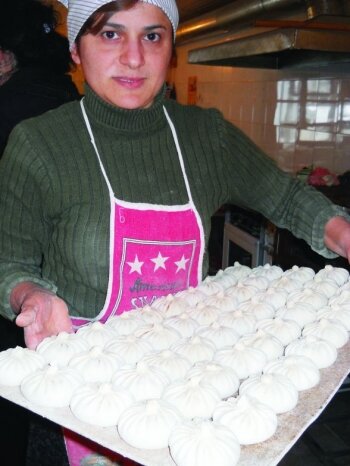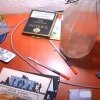
Mtiulian khinkali, fruit vodka and great history of a little town.
Ema Tukhiashvili
Georgian khinkali holds one of the honorable places among the most delicious dishes of the world. At any rate, every host boasts of this really delicious dish to any tourist who visits our country.
Khinkali is made in almost every region of Georgia but still none of hem can compete with the khinkali made in Mtiuleti. In order to learn about Georgia, one must by all means taste Georgian khinkali. The history of this dish is centuries old.
Ema Tukhiashvili
This dish is delectable during every season of the year but nothing can compare with it in frosty winter, when it’s snowing outside while you are having hot, steamy khinkali. That’s why we waited for the snow to fall and headed to Dusheti.
Dusheti is near Tbilisi; it’s about 40 minutes drive from the Capital city. Officially, it was declared a town in 1801. In 1756 it acquired the status of a federal town and in 1802 it became a central city of Dusheti District.
In the city there is a St. George church that dates back to IX-X centuries, a hall of a functionary, built in XVII century, the Chilashvili fortress of XVIII century and many architectural monuments and sights that must by all means be seen by the guests of Dusheti.
Walking through the virgin snow we approached the Bagrationi (Georgian royalty) and Karangozishvili fortress. The locals say that unique literature is kept in those centuries-old halls. An offspring of the Georgian royalty lives in Dusheti till now and the survived fortress located in the outskirts of the city belongs to him. Dusheti has preserved a house where Ilia Chavchavadze, famous Georgian writer and public figure worked as an arbitrator and lived there in 1864-1873. The building still retains its initial look despite the fact that tenants have been living there for many years. Nearby, you’ll find a historical building, where theater lovers society members used to gather in the last century.
Aleksi Akhalashvili (Dusheti resident): ‘At that time the center of Dusheti was located exactly at this place. Some time ago an interesting thing happened here – one of the streets of the city collapsed, revealing ruins of a brick-incased arch. As attested by the researchers, it was a remnant of an underground tunnel connecting the Bagrationi castle and Chilashvili palace in the village of Milakhvriaantkari.’
Before going to the village of Milakhvriaantkari not far from Dusheti, the locals offered us some fruit vodka: ‘You seem cold and this will warm you up’. They make this alcoholic drink from almost any kind of fruit but the most flavored is the one made of wild pears. At the beginning of autumn Dusheti dwellers collect the pear in the forest, press the fruit and keep the pear with oozing juice in hermetically closed casks. When the substance begins to ferment, move it to a distilling shop, put it on fire and make vodka. The wild pear vodka is a brand of Dusheti residents; it goes well with hot as well as cold dishes.
Five kilometers away, to the south of Dusheti, 900 meters up from sea level legendary Bazaleti Lake is sited. It is of volcanic origin and therefore it is filled and cleaned not by overland river currents but by subterranean waters. A modern tourist compound on its shore accommodates the guests in any season of the year. The visitors will be told a legend that is intended to impress them. The story has it that one of the Georgian kings buried the body of his deceased son that had been laid in the golden casket, in the waters of the Bazaleti Lake; this story was passed on through centuries. According to the other version, in the cradle that rests at the bottom of the Bazaleti Lake, Amirani, i.e. Prometheus was brought up and the gods had thrown it into the lake to punish the hero who stole the fire.
Having seen and heard everything, time comes to taste the dish in question. It is a shame for a Dushetian lady not to know how to wrap up khinkali. For this reason its preparation is given the status of creating a masterpiece.
Tina Tujishvili (Dusheti resident): ‘Mtiulian khinkali is made of beef and pork. For preparing khinkali the quality of meat is of utmost importance; therefore, newly slaughtered livestock is preferable. Ratio of meat is also important – beef must be about 70% and pork about 30%. The meat is minced; some salt, onion, dzira (fragrant plant) and some water are added to the stuffing to make it a bit watery, which makes up for juicy khinkali. Meanwhile, wheat flour dough is made. The flattened dough is cut in round pieces with the help of a tumbler and packed down to the size of a saucer. Then about one tablespoonful of seasoned meat is put on the flattened dough and wrapped up. The more creases it has, the better; normally it has 19-20 creases. In the meantime they boil water; when water is ready; they add some salt and dump raw khinkali into it. When kinkali swell up and start floating over the surface, it’s the sign that they are almost done. Before taking them out of the saucepan some cold water is to be sprinkled so that they don’t disintegrate. The boiled khinkali are put on a flat saucer and served together with black pepper. The only thing left after this is to wish the guest a good appetite’.
It is to be noted that Dusheti dwellers never reveal the full version of khinkali recipe. It is kept secret. But as they say in Georgia, even if it is an open secret, it’s almost impossible to make it as delicious as they make it in Dusheti.
Dusheti residents are also proud of making shish kebab on the grill – the fried pork lever on a skewer is so delicious that the guests never tire of praising the cuisine. At Lomisoba (one of the Christian festivals of Dusheti gorge) Dusheti inhabitants cook mutton and eat it together with warm beer. But I’ll tell you about it some other time, in another article.




















































